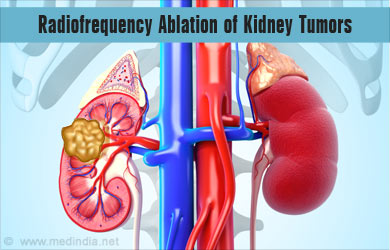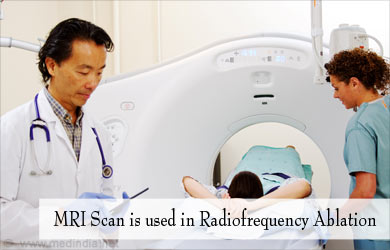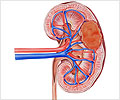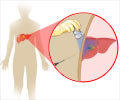- Ablation and Other Local Therapy for Kidney Cancer - (http://www.cancer.org/cancer/kidneycancer/detailedguide/kidney-cancer-adult-treating-ablation)
- Imaging-guided Radiofrequency Ablation of Renal Masses - (http://pubs.rsna.org/doi/full/10.1148/rg.24si045512)
- Radiofrequency Ablation (RFA) / Microwave Ablation (MWA) of Kidney Tumors - (http://www.radiologyinfo.org/en/info.cfm?pg=rfakidney)
- Radiofrequency treatment - (http://www.cancerresearchuk.org/about-cancer/type/kidney-cancer/treatment/radiofrequency-kidney-cancer)
- Radiofrequency ablation for cancer - (http://www.mayoclinic.org/tests-procedures/radiofrequency-ablation/basics/definition/prc-20013951)
- Patient Center - (http://www.sirweb.org/patients/kidney-cancer/)
What is Radiofrequency Ablation of Kidney Tumors?
Radiofrequency ablation is an image-guided procedure that uses electrical energy and heat in the treatment of cancer. It is a minimally invasive technique in which heat is used to destroy cancer cells. If the size of the tumor is reasonably small, then the entire tumor is destroyed, while in the case of large tumors, the size considerably shrinks.
Kidney cancer is among the 10 most common cancers in both men and women. Men are at a higher risk than women. Renal cell carcinoma (RCC) is the most common type of kidney cancer. Symptoms of kidney cancer include blood in urine (hematuria) back pain, weight loss, fatigue.
Kidney cancer was once detected after patients complained of pain, hematuria and doctors identified a palpable mass, with treatment being radical nephrectomy involving open surgery. Soon there was a detection of kidney tumors through routine ultrasound and other imaging techniques amongst asymptomatic individuals. These tumors were smaller as they were detected early, even before any noticeable symptoms (though some patients can be asymptomatic) and so there was a need to find procedures that were not intrusive and which spared the nephrons from damage. This coincided with a surge in minimally invasive techniques during the mid-1990s, heralding in a change in surgical procedures.
Radiofrequency ablation (RFA) is a technique that was initially used to treat liver cancer but from 1997 the procedure was also used for kidney carcinoma. Currently, RFA is the most commonly used procedure in the treatment of kidney carcinoma. The RFA technique can be used more than once on a patient.
Each Radiofrequency ablation procedure is unique and depends on location, type and size of the tumor, as well as history of chemotherapy or radiation. RFA is used to treat bone, lung, prostate and liver cancers.

Who are the Ideal Candidates for Radiofrequency Ablation?
Ideal candidates for RFA are patients with -
- Hereditary renal cell carcinoma
- Multiple bilateral renal cell carcinoma in Von Hippel- Lindau
- Small RCC with low renal reserve
- Poor candidature for open surgery
Who Should Not Opt for RFA?
Patients who should not opt for RFA are those with -
- Large tumors ( greater than 4 cms)
- Recent acute illness
- Tumors in the hilum or the collecting system
- Coagulopathy that remains uncorrected
- Low life expectancy
- Advanced age
- Recent cardiac problems

How is Radiofrequency Ablation Carried Out?
The 2 methods of performing an RFA are:
a) Percutaneous
b) Laparoscopic
In laparoscopic radiofrequency ablation the needle electrodes are threaded through a small hole in the skin in a procedure known as laparoscopy.
How is Radiofrequency Ablation Performed?
The patient must avoid taking aspirin or blood thinners and fasting from midnight the day before the procedure. When the RFA procedure is performed percutaneously, the patient is administered with local or general anesthesia.
Patients may have to stay overnight for observation after the treatment, though the procedure does not take too long.
How does Radiofrequency Ablation Work?
In radiofrequency ablation, an electrode is placed into the renal tumor using an image guided probe through which high-frequency electric current is transmitted. The probe delivers AC (alternating current) that result in the vibration of ions in the surrounding tissue. These vibrating ions cause frictional heat which causes tissue damage.
The molecular changes in the tumor due to RFA occur in 3 stages
Step 1: The heat generated by friction of ions results in -
- Protein denaturation
- Cell destruction
- Lipid melting
- Cellular vaporization
Step 2: Few days later: Tumor destruction occurs due to -
- Edema
- Coagulation necrosis
- Inflammation
Step 3: The necrotic tissue is reabsorbed by the body.
What Does the Success of Radiofrequency Ablation Depend On?
The success of an RFA procedure depends on -
- Precise tumor targeting
- Distribution of temperature
- Temperature of the probe
- Generator power
Temperature should be at least above 50o and latest generators have been found to power at least 100o. The temperature should not be higher than 105o as it can cause vaporization and leads to the development of gas.
What are the Imaging Techniques Used?
The imaging techniques that are commonly used are:
- Computed Tomography (CT)
- Ultrasonography
- Fluoroscopic CT
- Open interventional CT
- Magnetic Resonance Imaging (MRI)

Fluoroscopic CT and open interventional CT are techniques that allow real-time monitoring of the ablation procedure.
What is the Post-procedure Care for Radiofrequency Ablation?
The following care and advice should be given to the patient after the procedure:
- The patient would have to stay overnight at the hospital
- Doing heavy work or carrying heavy objects should be avoided for a few days after the procedure. Though most patients get back to routine within a few days
- Driving a car or taking important decisions should not be carried out for 24 hours due to the effects of an esthesia
- An oral antibiotic will be provided for a few days after the procedure.
Complications of Radiofrequency Ablation Procedure
The RFA is one of the most tolerated of procedures in cancer treatment. Most patients resume normal activity within a few days after the procedure. Some patients complain of pain and mild fever that may last for a few hours.
However, there are certain risks involved in the procedure and they include:
- In percutaneous insertion of the electrode for RFA, patients may complain of pain or paraesthesia at the site of insertion
- Perinephric hematoma
- Ureteropelvic junction may be obstructed
- Damage to ileus or the ureter
- Leakage of urine

Benefits of Using Radiofrequency Ablation in Treating Renal Cell Carcinoma
Though there are no long term studies currently available on the use of RFA in treating renal cell carcinoma, initial studies show promising results. The advantages of this procedure are:
- It is minimally invasive
- It requires short hospital stay
- Successful treatments involve reducing tumors to a scar
- It has a relatively low complication rate
- It can be repeated as required
- It is widely available








